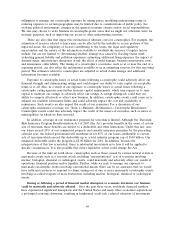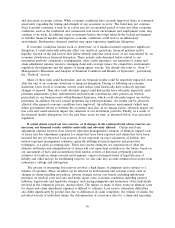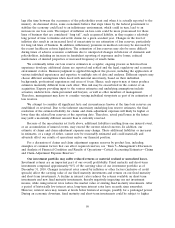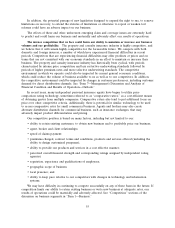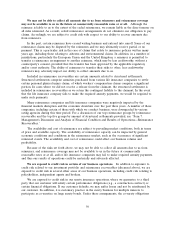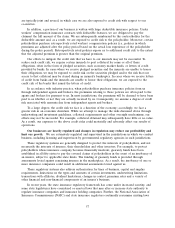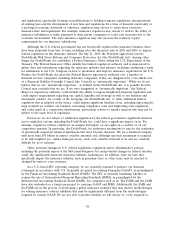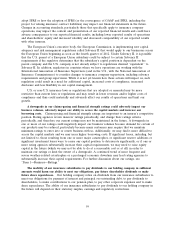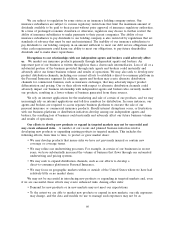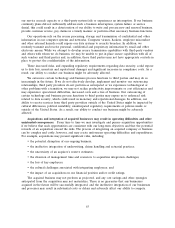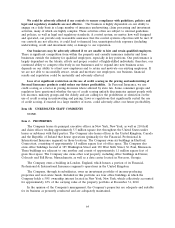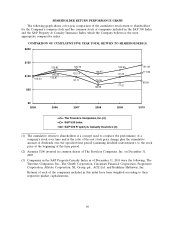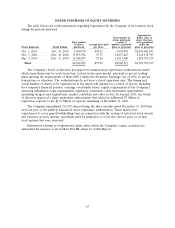Travelers 2010 Annual Report Download - page 69
Download and view the complete annual report
Please find page 69 of the 2010 Travelers annual report below. You can navigate through the pages in the report by either clicking on the pages listed below, or by using the keyword search tool below to find specific information within the annual report.are typically joint and several, in which case we are also exposed to credit risk with respect to our
co-sureties.
In addition, a portion of our business is written with large deductible insurance policies. Under
workers’ compensation insurance contracts with deductible features, we are obligated to pay the
claimant the full amount of the claim. We are subsequently reimbursed by the contractholder for the
deductible amount and, as a result, we are exposed to credit risk to the policyholder. Moreover, certain
policyholders purchase retrospectively rated workers’ compensation policies (i.e., policies in which
premiums are adjusted after the policy period based on the actual loss experience of the policyholder
during the policy period). Retrospectively rated policies expose us to additional credit risk to the extent
that the adjusted premium is greater than the original premium.
Our efforts to mitigate the credit risk that we have to our insureds may not be successful. To
reduce such credit risk, we require certain insureds to post collateral for some or all of these
obligations, often in the form of pledged securities, such as money market funds, or letters of credit
provided by banks. In cases where we receive pledged securities and the insureds are unable to honor
their obligations, we may be exposed to credit risk on the securities pledged and/or the risk that our
access to that collateral may be stayed during an insured’s bankruptcy. In cases where we receive letters
of credit from banks and the insureds are unable to honor their obligations, we are exposed to the
credit risk of the banks that issued the letters of credit.
In accordance with industry practice, when policyholders purchase insurance policies from us
through independent agents and brokers, the premiums relating to those policies are often paid to the
agents and brokers for payment to us. In most jurisdictions, the premiums will be deemed to have been
paid to us whether or not they are actually received by us. Consequently, we assume a degree of credit
risk associated with amounts due from independent agents and brokers.
To a large degree, the credit risk we face is a function of the economy; accordingly, we face a
greater risk in an economic downturn. While we attempt to manage the risks discussed above through
underwriting and investment guidelines, collateral requirements and other oversight mechanisms, our
efforts may not be successful. For example, collateral obtained may subsequently have little or no value.
As a result, our exposure to the above credit risks could materially and adversely affect our results of
operations.
Our businesses are heavily regulated and changes in regulation may reduce our profitability and
limit our growth. We are extensively regulated and supervised in the jurisdictions in which we conduct
business, including licensing and supervision by governmental regulatory agencies in such jurisdictions.
These regulatory systems are generally designed to protect the interests of policyholders, and not
necessarily the interests of insurers, their shareholders and other investors. For example, to protect
policyholders whose insurance company becomes financially insolvent, guaranty funds have been
established in all fifty states to pay the covered claims of policyholders in the event of an insolvency of
an insurer, subject to applicable state limits. The funding of guaranty funds is provided through
assessments levied against remaining insurers in the marketplace. As a result, the insolvency of one or
more insurance companies could result in additional assessments levied against us.
These regulatory systems also address authorization for lines of business, capital and surplus
requirements, limitations on the types and amounts of certain investments, underwriting limitations,
transactions with affiliates, dividend limitations, changes in control, premium rates and a variety of
other financial and non-financial components of an insurer’s business.
In recent years, the state insurance regulatory framework has come under increased scrutiny, and
some state legislatures have considered or enacted laws that may alter or increase state authority to
regulate insurance companies and insurance holding companies. Further, the National Association of
Insurance Commissioners (NAIC) and state insurance regulators continually reexamine existing laws
57



